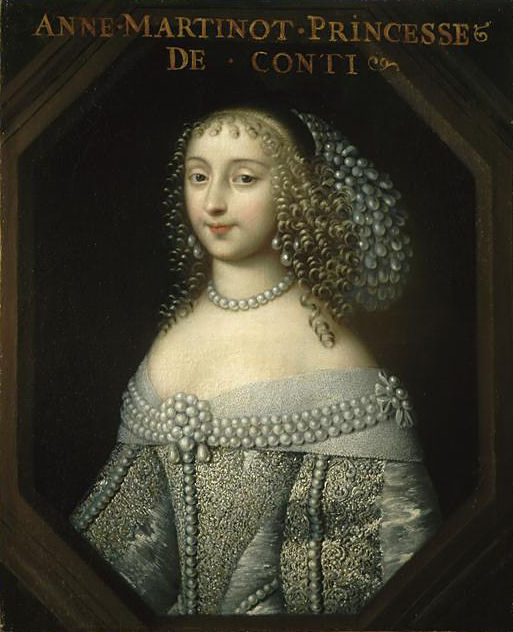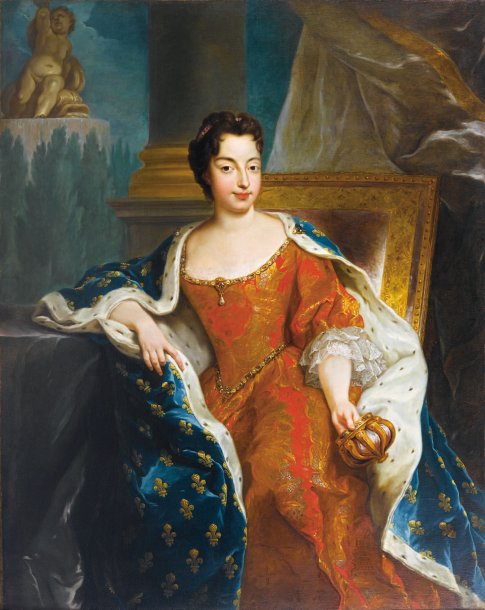Anne-Geneviève de Bourbon, Duchesse de Longueville
On 28 August in 1619, a girl was born in the dark prison of the château de Vincennes, which was sixty years later inhabited by poisoners awaiting their death sentences after plenty of torture.

That girl was Anne-Geneviève de Bourbon, the first child and only daughter of Henri de Bourbon, Prince of Condé, and his wife Charlotte-Marguerite de Montmorency. Her parents landed in the dreaded prison for their opposition against Concino Concini, Marquis d’Ancre, the Florentine favourite of Marie de Médicis.
Henri de Bourbon’s father, who had died before his birth, was a first cousin to Henri de Navarre. Thus after the death of Henri III and Henri de Navarre succeeding to the crown of France as Henri IV, Henri de Bourbon, being the nearest male relative of the new King, rose from relatively unimportant to Premier Prince du Sang and heir to the crown. He remained so until the birth of Louis XIII.
Henri IV had little affection for his cousin Henri, but kept a close eye on him and made sure he was educated well and raised as a Catholic. The King also found a wife for Henri. Rumour had it, that Henri de Bourbon showed a certain interest in his own gender, which Henri IV found rather good in that situation.
He had fallen in love with the fifteen year old Charlotte-Marguerite de Montmorency, who was a lady to his own wife and engaged to the Marquis de Bassompierre. Henri IV decided to break the engagement and have her marry his cousin Henri instead, in hopes cousin Henri might not show any interest in the girl and he could make merry with her. It did not work out that way. Charlotte was very taken with the old King, danced and flirted with him, which made Henri de Bourbon quite jealous… so he removed himself from court and took her with him. Henri IV apparently chased after them in various disguises. The King was assassinated shortly after that and Henri and Charlotte returned to Paris.
Like many others, they did not like the influence Concino Concini had over Marie de Médicis, who was the Regent of France for the young Louis XIII. Marie de Médicis eventually got fed up with the constant protests of the Prince de Condé and had him arrested. He was brought to the Bastille, then to Vincennes, where he was joined by his wife after requesting her company. Two months after the birth of Anne-Geneviève, Condé was released and allowed to rejoin court. They went to Paris with their infant daughter, who was styled Mademoiselle de Condé and a Princesse du Sang.
Little Mademoiselle de Condé was a mere six months old as she was engaged to the oldest son of Charles I de Lorraine, Duc de Guise. As Princesse de Sang and future Duchesse, she received a very strict education in the convent of the Parisian Carmelites in the Rue Saint-Jacques. In 1621, her mother gave birth to a boy, the future Grand Condé, and in 1629 another boy, Armand, followed. Anne-Geneviève and Armand stayed in Paris with their mother, while their brother Louis stayed with their father in Bourges.

It was not an easy time for Mademoiselle de Condé. In 1627, her mother’s cousin François de Montmorency-Bouteville was beheaded at the Place de Grève for duelling and in 1635 her uncle, her mother’s only brother, Henri II de Montmorency was beheaded for conspiring against Cardinal Richelieu.
Anne-Geneviève was considered to be a true beauty already as a child and came to love literature. After her parents had made peace with Cardinal Richelieu, Mademoiselle de Condé was introduced to the court in 1635. She quickly became a star of the salons, especially that of the Hôtel de Rambouillet, the witty and merry centre of wisdom in Paris. She also collected quite a few admirers eager to gain signs of her esteem.
The son of the Duc de Guise, to which she was engaged, died in 1639 and that prompted a husband search. Her father took in mind to have her marry Jean-Armand de Maillé, a nephew of Richelieu, but the Cardinal declined. The Prince de Condé had already arranged for the marriage of his heir Louis and Richelieu’s niece Claire-Clémence de Maillé-Brézé, so it took him utterly by surprise that the Cardinal declined, but Richelieu insisted that while it might be fine for a Prince to marry a “normal” girl, it would not be fitting for a Princesse to marry below her rank.
Thus Mademoiselle de Condé was engaged to Henri II d’Orléans, Duc de Longueville. The Duc was already widowed and twice her age. Needless to say that Anne-Geneviève was not at all into him. The marriage took place on 2 June in 1642 and their first child, a daughter named Charlotte-Louise, was born in 1644. She only lived for a year.
The family of the now Duchesse de Longueville became of great importance again after the death of Louis XIII. Her father became chief of the council of regency for the young Louis XIV and her brother Louis won great victories on the battlefield in the name of the young King. Charming, smart and beautiful as Anne-Geneviève was, she was allowed to accompany her husband to Münster. The Duc had been sent there as chief envoy by Cardinal Mazarin to take part in the negotiating of the Treaty of Westphalia. The gentlemen there were very taken by the Duchesse and nicknamed her the “goddess of peace and harmony“…. and then the Fronde happened.
The prince de Condé died in 1646 and the title went to her younger brother Louis. Anne was pregnant with her second child then. This child, a boy named Jean-Louis, suffered of mental health issues and spent much of his time cloistered.
Upon returning from Münster, the Duchesse de Longueville fell madly in love with the then Prince de Marcillac, who later became famous as writer as the Duc de Rochefoucauld. They became lovers and were fond of the ideas behind the first Fronde. Marcillac used Anne-Geneviève’s influence over her youngest brother Armand, Prince de Conti, to gain his support for the matter. Talk had it the Prince de Conti was in love with his sister. They also tried to win the new Prince de Condé over, but it was in vain in first.

Anne took her daughter, Marie-Gabrielle, who was born in 1647, and moved together with her husband and her brother Armand into the Hôtel de Ville of Paris. The city was in great unrest and they were in open rebellion against Cardinal Mazarin. The Duchesse gave birth to a child, whose father is said to be the Prince de Marcillac, in the Hôtel de Ville. She named the child Charles-Paris and made Paris the godmother of the boy.
Anne d’Autriche eventually ordered the arrest of the Prince de Condé, who had changed sides in the meanwhile thanks to Anne-Geneviève, and his brother the Prince de Conti as well as that of the Duc Longueville in January 1650. The Duchesse fled to Normandy and tried to raise the province in support of those arrested, but loyal royal troops were at her heels. She managed to escape arrest and travelled to The Hague on a Dutch ship, then travelled to Stenay, which she reached in March 1650, and sought refuge with Turenne.
The Vicomte de Turenne took a fancy in the Duchesse and was persuaded by her to join the Fronde mess as well. The whole thing went of course terribly wrong. One after the other, Turenne and the Princes made peace with the crown, lured by wealth and good marriages. The Fronde came to an end, the Prince de Marcillac who had in the meanwhile taken the title Duc de La Rochefoucauld broke with the Duchesse, after he heard of her acting intimate with Charles-Amédée de Savoie.
Anne-Geneviève, the great lady of the Fronde, was alone, disgraced and abandoned by her former friends. She was put under house arrest at Montreuil-Bellay and Moulins, before she joined her husband in Rouen. There she took to religion and devoted herself to charity until 1663, when her husband died and she returned to Paris. Anne joined the Jansenism movement and started to regret what she had done during the Fronde. Her oldest son resigned his rights to his father’s titles and became the Abbé d’Orléans. Charles-Paris was killed leading the attack in the passage of the Rhine in 1673.
Louis XIV eventually pardoned her and she became protector of the abbey of Port-Royal des Champs and Jansenism. Anne returned to the Carmelites of the Rue Saint-Jacques, where she had been educated, and hardly ever left the convent until her demise on 5 April in 1679. Her brother the Prince de Condé had her buried with great pomp at the Église Saint-Jacques-du-Haut-Pas and her heart, as she wished, sent to the nuns of Port-Royal. Her remains were removed in the 1850s and brought to the Catacombes de Paris.





